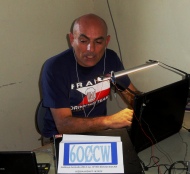The Amateur Radio payload on the lunar-orbiting 4M-LXS spacecraft will carry
up to 2500, 13-character digital messages into space for retransmission via
JT65B mode on 145.990 MHz. But wannabes will have to act fast. The message
collection site will close Wednesday, September 17 at 12:00 Central European
Time (1100 UTC) the
4M
website announced today. China recently
announced
plans to launch the orbiter carrying the 14 kg battery-powered payload,
developed by LUXspace in Luxembourg. The International Amateur Radio Union (
IARU) is a partner in the
experiment. Getting a message into space requires
registering and
uploading one via the 4M website. A “73 de W1AW” message already
has been uploaded.
“Give us your 13 characters long message, and we will send it ‘from the
moon,’” an announcement on the 4M Manfred Memorial Moon Mission website invites.
Signals from the Amateur Radio payload can be decoded using the free
WJST
software by Joe Taylor, K1JT. The Manfred Memorial Moon Mission
memorializes
Manfred Fuchs, the late founder and chairman of LUXspace parent company OHB of
Bremen. He died in April. The 4M mission is expected to launch after 1800 UTC on
October 23.
According to LUXspace, the 4M spacecraft will transmit continuously on
145.980 MHz (± 2.9 kHz) at 1.5 W into a simple quarter-wave
monopole antenna. “This will give S/N comparable to EME signals at Earth’s
surface,” LUXspace said. “The transmission is based on a 1-minute sequence and a
5-minute cycle. The transmission will start 4670 seconds (77.8 minutes) after
launch.”
The 4M mission was detailed during a
presentation
the EME 2014 conference held recently in France. A
paper,
“4M Mission: A Lunar Flyby Experiment” also is available. During the
lunar flyby, the spacecraft will be about nearly 248,000 miles from Earth and
between 7440 and 14,480 miles from the Moon. The spacecraft will be part of the
last stage of the lunar mission. The planned trajectory calls for a lunar flyby
and return to Earth, with a 90 percent chance that the spacecraft will re-enter
Earth’s atmosphere. LUXspace has provided a
tracking tool on
its website.
The mission is scheduled to run slightly longer than 8 days, with lunar flyby
occurring about halfway through the mission. The distance to the moon will be
between 7440 and 14,480 miles, depending on the final orbital injection vector,
LUXspace said.
LUXspace’s motive in encouraging radio amateurs to upload messages is to
guarantee a built-in team of listeners who will monitor the transmissions and
report back to LUXspace. “There will be a number of experiments and contests
with prizes to the winners in each experiment and category,” LUXspace said.
The orbiter is one of the test models for Beijing’s new lunar probe
Chang’e-5, which will land on the moon, collect samples, and return to
Earth. The launch is aimed at testing technologies vital to that spacecraft’s
success. The orbiter will be launched into Lunar Transfer Orbit and then perform
a lunar flyby before re-entering Earth’s atmosphere.
The orbiter, which arrived by air in Xichang, Sichuan, on August 10, has been
transported to the Xichang Satellite Launch Center. —
Thanks to LUXspace,
AMSAT-UK
'73 de IK1XPK, Claudio

























.gif)
.gif)
.jpg)